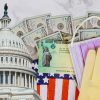The Johns Hopkins Institute for Education Policy, founded in 2015, is known for its non-partisan, research-based approach to education policy. Ashley Berner, deputy director of the Institute, is a research and policy expert on the ways democracies around the world approach the structure, content, and accountability measures of their school systems.
In this interview, Berner discusses what the federal Coronavirus Aid, Relief and Economic Security (CARES) Act, signed into law on March 27, does and doesn’t do for K-12 education. The Institute research team has summarized the CARES Act for leaders from all different school types, including district, charter, and private.
Q: The CARES Act is a massive relief package that includes checks to households, funding for certain industries, and small business loans. What does it do for K-12 education?
A: The act provides states with two separate funding streams for K-12 education: one to the governors’ offices, the other to a state’s education agency (SEA). These funds are calculated differently and may serve different needs in a state. The governors’ funds are smaller and more flexible; they can be used to support educational services more broadly, including colleges and universities, charter schools, and private schools. The SEA’s funds, by contrast, must be allocated to districts, for any of 12 different purposes set out in the act.
There is some nuance here. In some states, charter schools are considered their own type of district and would thus receive commensurate funding, and in all states, districts must share funds with private schools that serve low-income students (the Title I program).
The act also provides a separate rural-development item that supports distance learning and a paycheck protection program for nonprofits that could certainly help non-public schools pay their teachers and staff in the short term.
Q: What doesn’t the act do, that perhaps could have been done, for K-12?
A: It doesn’t include E-Rate funding that would expand broadband internet and provide internet-connected devices for students. This is a huge problem for schools that serve low-income families, whose access to online learning is uneven. The technology gap will most certainly be addressed in future legislation. Philanthropies are stepping up their support in the meantime, and we’ve heard about really some creative ways to solve the problem. For instance, Great Minds, which is a provider of high-quality curriculum, will be broadcasting daily lessons on public television here in Baltimore. This is excellent news, as Baltimore City Public Schools uses Great Minds materials in English and Math, and faces enormous challenges with access to the Internet.
Q: What else are you seeing in the field during COVID-19?
A: Concerns around the provision of equitable services for special-needs students, many of whom require in-person support. And the “summer melt” phenomenon, in which students—particularly, vulnerable students—lose ground during the summer months, will be particularly acute this year. Policymakers and practitioners are trying to get ahead of those two issues, among all of the other logistical and pedagogical challenges they are dealing with on a daily basis.

